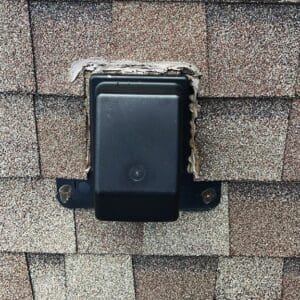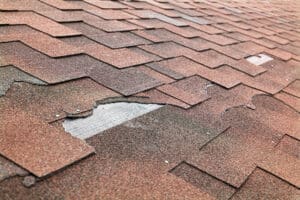
13 Common Roof Leaks
Roof leaks suck! We know. We have performed thousands of leak repairs since we began in 2003. But what if you could prevent the leaks before they happen? We will discuss 13 of the most common roof leak repairs we have performed and tell you how you can prevent them.
1. Pipe Jacks
Pipe jacks are commonly the leaky roof repair suspect. Both lead and galvanized pipe flashing will eventually cause problems. Lead pipe jacks can be installed improperly, damaged in storms, or damaged in multiple ways. Galvanized pipe jacks have a rubber boot; after years of sun exposure, they will dry out, become brittle, and crack. Inspecting pipe jacks yearly will keep them from being the origin of some nasty water damage.

2. Vents
Roof vents are another source of common roof leaks. Box vents come in two materials, metal and plastic. Plastic roof vents can be cracked by hail and flying debris. Metal roof vents can also be damaged in storms and high winds, eventually corroding and leaking.
Another roof vent that can cause major roof leaks is the turbine vent. High winds will blow off turbine tops leaving a very large hole in your roof. If not repaired quickly, even a small storm can cause massive amounts of damage.
3. Nail Penetrations
Exposed nail penetrations must be sealed regularly with a silicone-based caulk sealant. The sealants hold up to severe weather, but after a few years, the sealant will break down and lose its adhesion. Inspecting nail penetrations is crucial to every roof inspection and evaluation we perform.
4. Hail Damage
Hail-damaged shingles are a very common source of roof leaks. Large hail severely weakens the integrity of shingles. The impact of hail knocks off the granules from the shingle, exposing the felt. Granule loss allows the asphalt shingles to be acceptable to greater UV damage, leading to roof leaks.
After any hailstorm, homeowners should have their roofs inspected by a professional roofing company. Most roofing companies will provide free inspections, provided if there is damage, you will choose them to repair or replace the roof.
5. Lifted Shingles
Lifted shingles mean that the seal has broken or become ineffective. High winds blow up the shingles and allow wind-driven rain to get under the shingles, compromising the roofing system. Lifted shingles can be repaired or replaced depending on if the shingles were damaged.

6. Broken Shingles
As asphalt shingles age, they become brittle, crack and break. Broken shingles need to be repaired immediately to keep water leaks to a minimum. However, sometimes broken shingles are not repairable when the roof is already too old and brittle. Trying to repair these roofs will just break the shingles around the repair.
7. Missing Shingles
High winds blow shingles off the roof, exposing the felt paper or deck below. Missing shingles allow water under the shingle system and in through the roof deck. If you discover shingles in the yard, contact a roofing company immediately.
8. Flashing
Roof flashings are used in roof to vertical transitions like against siding or a chimney. Flashings can be installed incorrectly or rust and fail. Flashings should be inspected regularly to keep them in the best condition.
9. Poor Workmanship
A large percentage of the leak repair calls we get are related to poor workmanship. Unfortunately, we have seen every bad installation possible. From using the wrong type of roof system to poorly cut valleys and bad flashing jobs. We have even seen box vents installed backward. We see endless potential leaks anytime a bad roofer puts on a roof. Never trust your home to a company that you can not research.
Bad satellite installation is another poor workmanship issue that leads to leaks. Finding a qualified person to install the satellite properly can be difficult.
10. Cracked Hip and Ridge Shingles
Cracked hip and ridge shingles also make the list. Shingles used for the hip and ridge on a 30-year dimensional roof are cut from a three-tab roof shingle. This is standard practice. Because the shingles are bent over the ridge, they are already predisposed to faster degradation. As the shingles age, cracking begins at the top of the ridge shingle, where it is bent the most. Additionally, hail can knock holes in ridge cap more easily than on the field for the same reason as stated above.
To prevent leaks from occurring, the ridge and hip shingles should be inspected closely for any wear or hail bruises.
11. Siding
Sometimes roof leaks are not roof leaks at all, sometimes they are siding leaks. Two-story homes with siding walls that buts up to roof shingles or the siding on a chimney are prime candidates for leaks. Siding should be cut above the roof to prevent the siding from absorbing the water, swelling, and eventually rotting.
Maintaining the exterior paint is also essential to prevent water leaks. Paint and caulking protect the siding materials and seals them from the water.
12. Physical Damage
Physical damage to roof shingles creates roof leaks. An example of this is a tree limb that touches the roof blowing in the wind, slowly damaging the shingles. Even things like allowing leaves to stay on the roof will weaken the roofing system. Cleaning the roof of debris 2 to 4 times a year and keeping trees trimmed will give your roof a longer life.
13. Animal Damage
Squirrels sure are cute to watch running around the yard up the trees, but when they are on your roof, they can wreak havoc. Squirrels love to chew on the lead pipe jacks on the roof. Lead tastes sweet to them, so they keep coming back for more. Many rodents have a sweet tooth for lead as well.
Inspect the pipe jacks closely for any chew marks before they become full holes. There are specialty products on the market designed to deter animals from your lead pipe jacks; however, replacing the pipe jacks with neoprene boots works.
Back to Blog